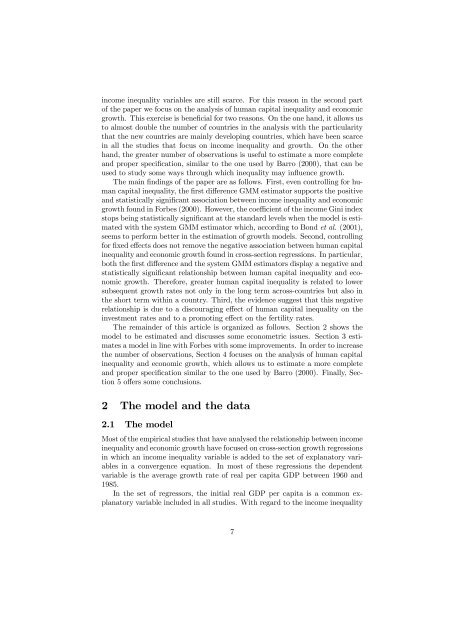Amparo Castelló-Climent, Universidad Carlos III de Madrid ... - Ivie
Create successful ePaper yourself
Turn your PDF publications into a flip-book with our unique Google optimized e-Paper software.
income inequality variables are still scarce. For this reason in the second part<br />
of the paper we focus on the analysis of human capital inequality and economic<br />
growth. This exercise is beneficial for two reasons. On the one hand, it allows us<br />
to almost double the number of countries in the analysis with the particularity<br />
that the new countries are mainly <strong>de</strong>veloping countries, which have been scarce<br />
in all the studies that focus on income inequality and growth. On the other<br />
hand, the greater number of observations is useful to estimate a more complete<br />
and proper specification, similar to the one used by Barro (2000), that can be<br />
used to study some ways through which inequality may influence growth.<br />
The main findings of the paper are as follows. First, even controlling for human<br />
capital inequality, the first difference GMM estimator supports the positive<br />
and statistically significant association between income inequality and economic<br />
growth found in Forbes (2000). However, the coefficient of the income Gini in<strong>de</strong>x<br />
stops being statistically significant at the standard levels when the mo<strong>de</strong>l is estimated<br />
with the system GMM estimator which, according to Bond et al. (2001),<br />
seems to perform better in the estimation of growth mo<strong>de</strong>ls. Second, controlling<br />
for fixed effects does not remove the negative association between human capital<br />
inequality and economic growth found in cross-section regressions. In particular,<br />
both the first difference and the system GMM estimators display a negative and<br />
statistically significant relationship between human capital inequality and economic<br />
growth. Therefore, greater human capital inequality is related to lower<br />
subsequent growth rates not only in the long term across-countries but also in<br />
the short term within a country. Third, the evi<strong>de</strong>nce suggest that this negative<br />
relationship is due to a discouraging effect of human capital inequality on the<br />
investment rates and to a promoting effect on the fertility rates.<br />
The remain<strong>de</strong>r of this article is organized as follows. Section 2 shows the<br />
mo<strong>de</strong>l to be estimated and discusses some econometric issues. Section 3 estimates<br />
a mo<strong>de</strong>l in line with Forbes with some improvements. In or<strong>de</strong>r to increase<br />
the number of observations, Section 4 focuses on the analysis of human capital<br />
inequality and economic growth, which allows us to estimate a more complete<br />
and proper specification similar to the one used by Barro (2000). Finally, Section<br />
5 offers some conclusions.<br />
2 The mo<strong>de</strong>l and the data<br />
2.1 The mo<strong>de</strong>l<br />
Most of the empirical studies that have analysed the relationship between income<br />
inequality and economic growth have focused on cross-section growth regressions<br />
in which an income inequality variable is ad<strong>de</strong>d to the set of explanatory variables<br />
in a convergence equation. In most of these regressions the <strong>de</strong>pen<strong>de</strong>nt<br />
variable is the average growth rate of real per capita GDP between 1960 and<br />
1985.<br />
In the set of regressors, the initial real GDP per capita is a common explanatory<br />
variable inclu<strong>de</strong>d in all studies. With regard to the income inequality<br />
7

















